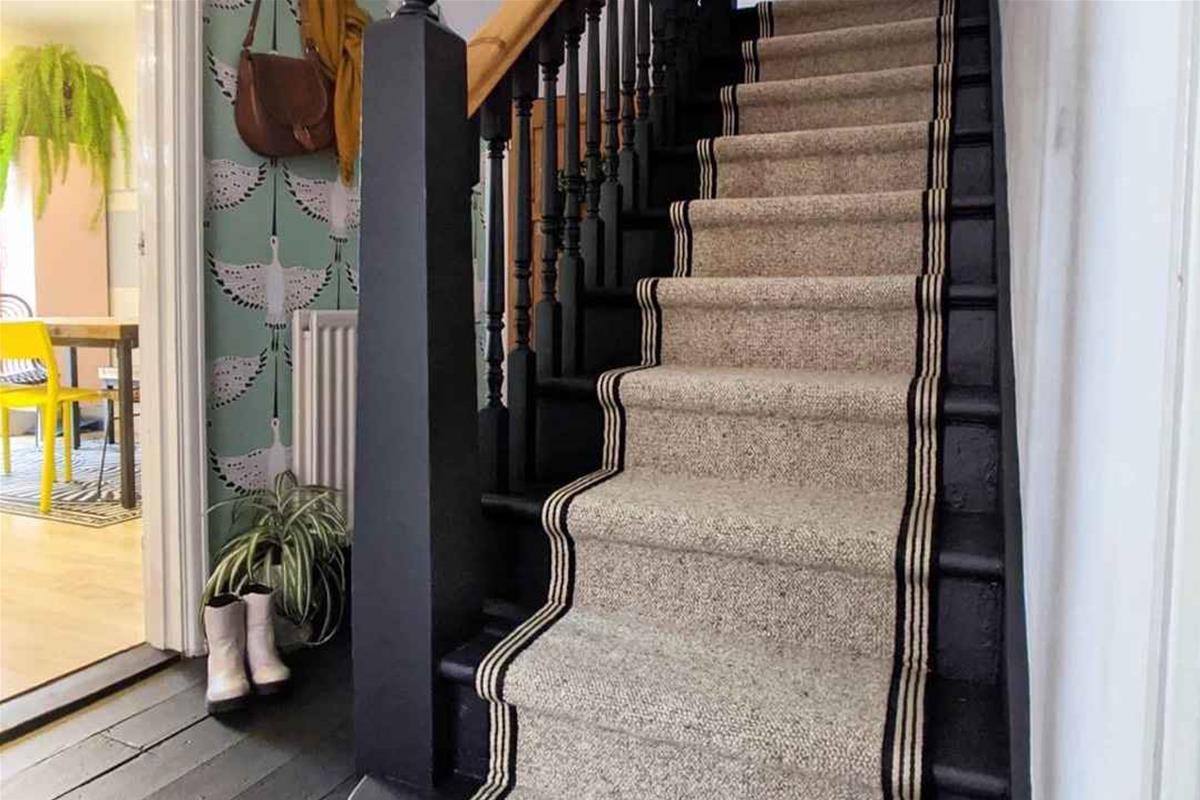All you need to know about wool carpets and stair runners
03 January 2024
Interested in investing in a wool carpet or stair runner?
Check out the blog on all you need to know about wool carpet, advantages, disadvantages and cleaning tips.
Links for our wool stair runner and carpet ranges below
https://stairrunnersdirect.com/stair-runners/herringbone/wool

Natural and Sustainable
Wool carpet is made from the fibres of sheep's wool, making it a natural and renewable resource. It is considered an eco-friendly flooring option as it is biodegradable and can be recycled.
Softness and Comfort
Wool fibres are soft and provide a luxurious feel underfoot. They offer excellent cushioning and insulation properties, making wool carpet a cosy and comfortable choice for bedrooms, living rooms, and other areas where comfort is important.
Durability
Wool is one of the most durable carpet materials available. It has natural elasticity, which allows it to retain its shape and bounce back from compression. Wool fibres can withstand heavy foot traffic and tend to resist wear and crushing better than synthetic carpets.
Resilience
Wool carpet has inherent crush recovery, meaning it can bounce back to its original shape after being flattened. This makes it highly resistant to furniture marks or imprints, which are commonly seen with other types of carpet.
Insulation
Wool naturally provides thermal and acoustic insulation. It helps to maintain comfortable indoor temperatures by retaining heat during colder months and offering insulation against heat during warmer months. Additionally, wool absorbs sound, reducing noise transmission between floors.
Air Purification
Wool fibres have the ability to purify indoor air by absorbing and locking away common airborne contaminants like formaldehyde, nitrogen dioxide, and sulfur dioxide. This can result in improved indoor air quality and a healthier living environment.
Stain and Spill Resistance
Although not entirely stain-proof, wool carpet has natural water and oil resistance due to the structure of its fibres. This resistance allows spills to be contained near the carpet's surface, giving you more time to clean up before stains can set.
Colours and Patterns
Wool carpet comes in a wide array of colours and patterns, allowing for versatile design options. Wool readily accepts dyes, resulting in vibrant and rich colour choices. This versatility enables homeowners to find a style that suits their aesthetic preferences and complements their interior decor.
Maintenance
Wool carpet requires regular maintenance to keep it looking its best. It should be vacuumed regularly to prevent dirt and debris from accumulating. Professional cleaning every 12 to 18 months is recommended to remove deep-seated dirt and maintain the carpet's appearance.
Cost
Wool carpet tends to be more expensive than synthetic options due to its premium quality and natural properties. However, its longevity and durable nature often justify the higher upfront investment.
In conclusion, wool carpet offers a range of benefits including comfort, durability, insulation, air purification, and aesthetic appeal. While it may require regular maintenance and involve a higher cost compared to synthetic alternatives, its many advantages make it a popular choice for homeowners seeking a luxurious and environmentally friendly flooring option.
Cleaning a wool carpet requires a delicate approach to prevent damage and preserve its quality. Here's a step-by-step guide to effectively clean a wool carpet
1) Regular Maintenance
- Vacuum your wool carpet at least once a week to remove loose dirt and particles. Use a vacuum cleaner with a gentle suction and a brush attachment, or one specifically designed for wool carpets.
- Rotate your furniture periodically to prevent excessive wear on specific areas of the carpet.
2) Spot Cleaning
- Attend to spills or stains immediately to minimise any potential damage. Blot the spill gently with a clean, dry cloth or paper towel to absorb as much liquid as possible.
- Avoid rubbing or scrubbing vigorously, as it can push the stain deeper into the carpet fibers.
- If the stain persists, apply a small amount of wool-safe carpet cleaner or liquid dish soap mixed with water (follow the manufacturer's instructions) to a clean, white cloth, and dab the affected area. Blot with a clean, damp cloth afterward to remove any residue.
3) Professional Cleaning
- To ensure a thorough cleaning and extend the life of your wool carpet, it is recommended to have it professionally cleaned every 12-18 months.
- Look for a professional carpet cleaning service that specialises in wool carpets and uses a gentle, pH-neutral cleaning solution.
- Prior to scheduling the cleaning, ask the service provider about their cleaning methods and equipment to ensure they meet the requirements for wool carpets.
4) Preventive Measures:
- Consider using area rugs or runners in high-traffic areas to reduce wear and tear on the wool carpet.
- Place doormats at entrances to prevent dirt and debris from being tracked onto the carpet.
- Use furniture coasters or pads under heavy furniture to distribute the weight and minimise indentation on the carpet.
Remember, it's important to always refer to the manufacturer's guidelines and recommendations for cleaning your specific wool carpet, as they may have additional care instructions.
See below for links to manufacturers cleaning guidelines.
https://www.fibreflooring.com/wp-content/uploads/2017/07/Wool-Flatweave-care-and-cleaning-guide.pdf
https://www.alternativeflooring.com/help-advice/product-care#wool-carpets

